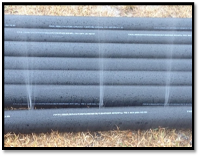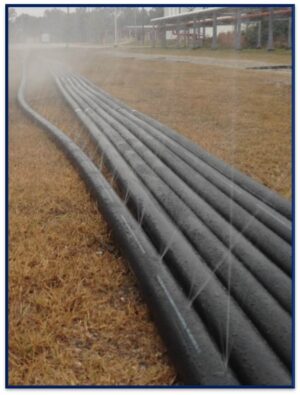Directional Technologies provided horizontal well design alterations for successful remedial results at a bulk fuels facility in North Carolina. Even at highly characterized and delineated sites, physical site restrictions can prevent the ability to implement proposed remedial designs successfully. Directional Technologies utilized over 30 years of experience designing and installing horizontal remediation wells to make design suggestions that led to the successful installation of three horizontal air sparge wells despite physical restraints on site.
Background and Setting
The site, located in North Carolina, operates as a bulk fuel facility. Site features include multiple above-ground storage tanks, storage buildings, office space, above-ground transfer piping, and multiple underground pipelines. It is positioned with a river to the west, vacant land to the north and south, with a road and railway to the east. Numerous soil and groundwater investigations have been performed at the site since the first release was reported in 1985. Various remedial strategies have been implemented at the site since 1985, including an interceptor trench, ex-situ thermal oxidation of soil, air sparge (AS) and soil vapor extraction (SVE), product recovery system, and groundwater recovery and treatment.
Before Directional Technologies’ involvement at the site, a horizontal AS well was installed in 2019 for a pilot study application of bio-sparging. The well was installed utilizing the entry-exit installation technique, which requires an entry pit in front of the drill rig and an exit pit on the terminal end of the bore where the well material is staged and pulled back into place. In 2022, Directional Technologies was contracted to install three (3) additional horizontal AS wells to target existing contaminant hot spots and boost bio-sparging activities at the site.
On-Site Obstructions Preventing Access
The site is located at an active fuel facility where on-site obstructions prevented subsurface contamination access. The contaminant plume, consisting primarily of naphthalene and xylenes, extended laterally beneath active railroad tracks to the south, storage buildings to the west, and multiple fuel storage tanks to the east and north. For the site to be successfully remediated, access to the plume’s core beneath these existing facilities had to be acquired. Since the property was an active work facility, Directional Technologies also had to minimize interruptions to daily business activities so that the client could maintain their regular workload.
The ideal design for the remediation system involved horizontal AS wells positioned in a north-south orientation to access the critical portions of the plume. However, to complicate the site conditions further, a large-scale drainage system was in place at the exit end of the proposed horizontal well locations to the north.
Designing a Successful Horizontal Remediation Well System
Directional Technologies teamed up as a collaborative partner with the environmental consultant to design and implement a horizontal AS system that would meet the remedial goals of the project. During the installation phase, the Directional Technologies crew implemented a critical installation alteration compared to the previously installed pilot well. Rather than using the entry-exit installation technique, which requires accommodation space for an exit location on the terminal side of the well, Directional Technologies instead utilized the blind installation technique. The process of blind installation is a highly functional process that solely requires an entry point, eliminating the need for the pipe to exit on the other end of the bore.
Had the entry-exit installation technique been used to install the successive horizontal AS wells, the optimal north-south well design could not have been executed because the exit riser would have impacted the existing drainage system. As a result of utilizing blind installations, the screens of the horizontal AS wells were installed beneath active railroad tracks, continued north beneath several existing fuel tanks, and were terminated in the subsurface before impacting the existing drainage system. Over two hundred feet of screen were installed per horizontal AS well, providing unparalleled bio-sparging access to the core of the contamination plume despite site limitations.
Figures: Visual Representation of air-flow distribution using water with horizontal wells.
Results:
Directional Technologies successfully installed the three horizontal AS wells despite the physical challenges at the site. By providing the environmental consultant with the design alteration to use blind installation techniques during the active drilling process, the optimum bore path for the remedial design could be maintained. Simultaneously, additional drilling footage and associated materials required for the entry-exit technique were eliminated, saving project funds while achieving the remedial goals.
How can the advantages of decades of technological advancement in horizontal wells benefit your project? Call our horizontal remediation well experts at 1-877-788-4479 to discuss your current project needs.
Written by: Elliott Andelman, Environmental Scientist

